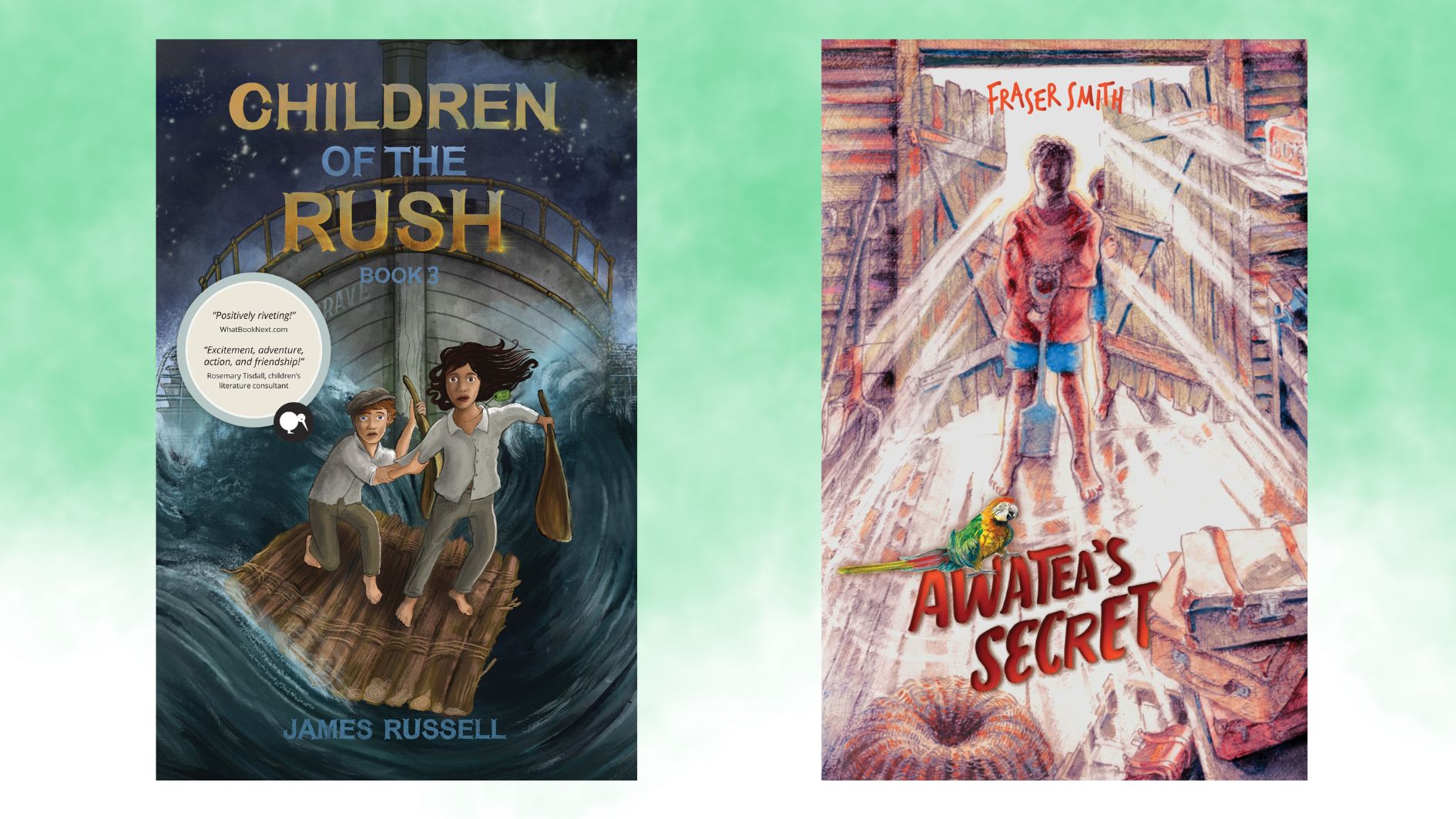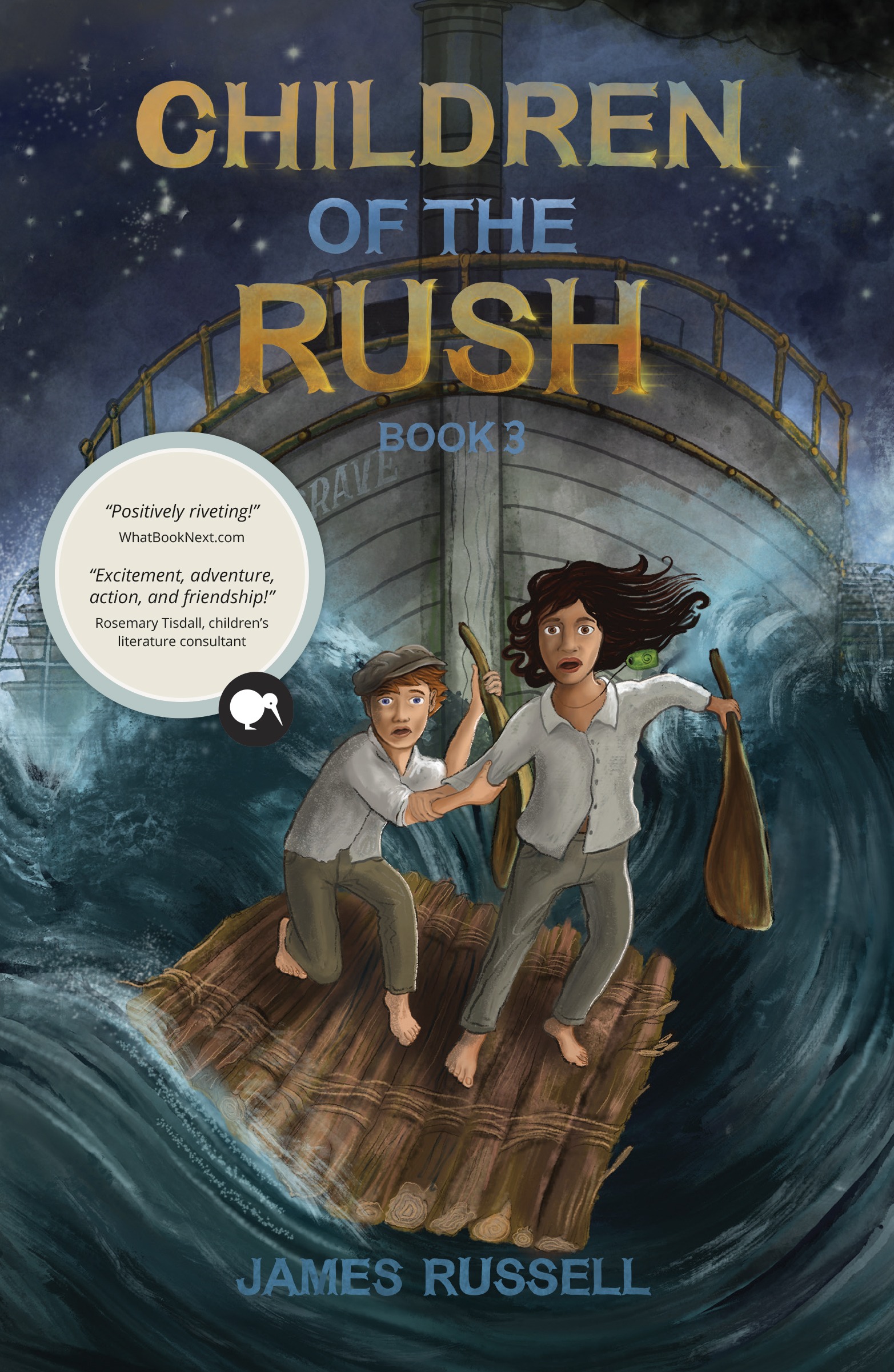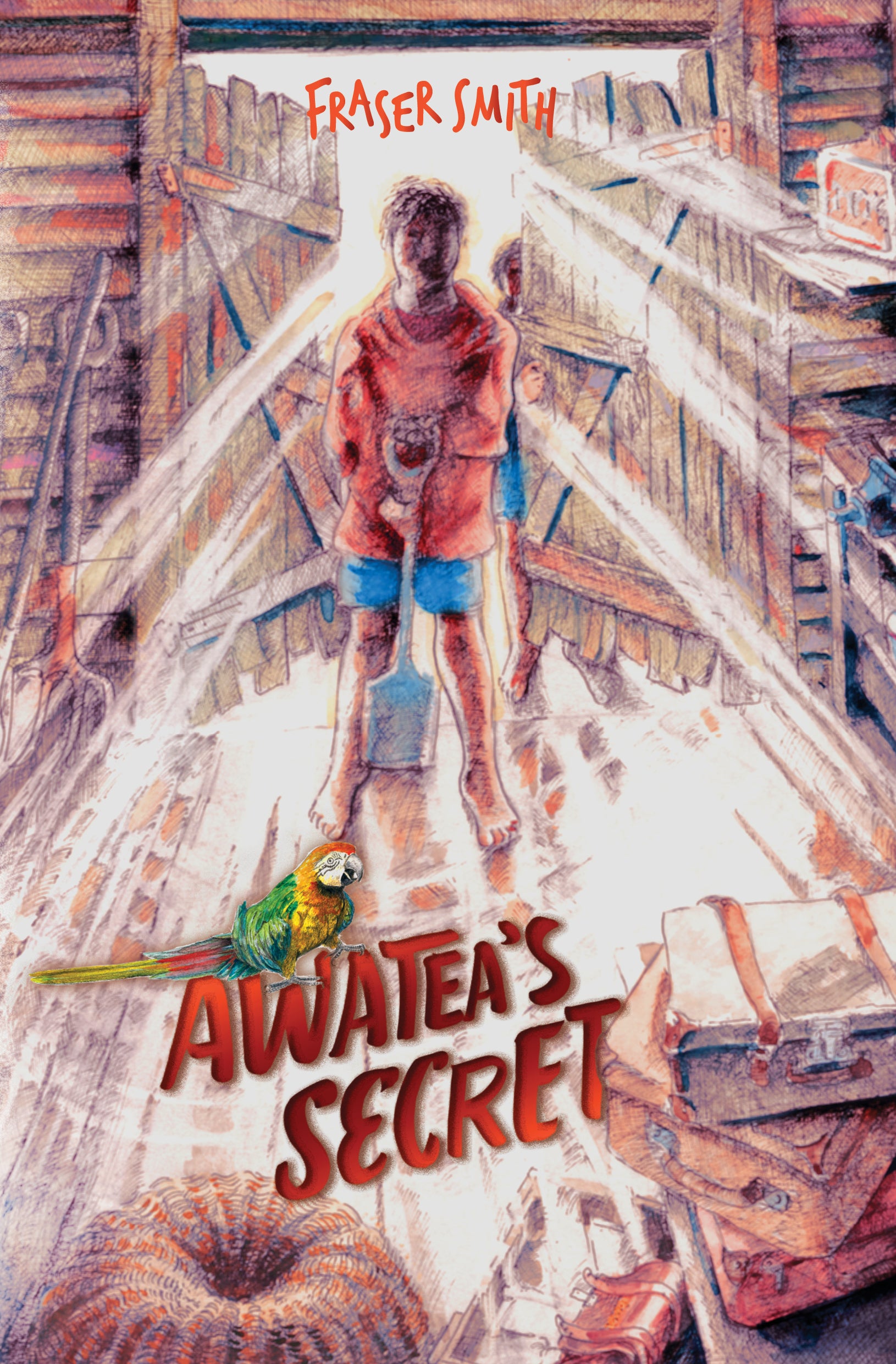Fiona Giles reviews new junior fiction books from James Russell and Fraser Smith.

Children of the Rush: Book 3, by James Russell
This rip-roaring adventure had me glued to my seat as I devoured it in one sitting.
Book three of Children of the Rush is the final in this historical trilogy detailing the adventures of three children in 1860s New Zealand who all possess a strange magical talent; Māori girl Atarangi, Pākehā boy Michael and Chinese girl Siu. Readers who haven’t read the prior books will not be left feeling lost, however, as Russell deftly weaves the backstory into the narrative, catching everyone up. This engaging novel is also lush with historical detail and seamlessly weaves in te reo Māori. Readers will learn without noticing it’s happening, including tidbits about Canterbury’s wool lords, the sale of the West Coast for £300, and two ways of cooking īnanga (whitebait).
The three children and their families—having formed a wee clan of their own away from the prejudice Chinese miners and Māori often faced at this time—have made their way to Hokitika, just as the 1864 gold rush takes off. Here, Michael’s father, Atarangi’s mother and uncle, and Sui’s father build a home. Circumstance conspires to send the adults away leaving the children, feeling very grown up, to look after themselves.
… lush with historical detail
The narrative opens with the trio visiting fortune teller Madame Destiny (who is wonderfully described with a lavish attention sadly afforded to no other character). It’s not clear why the trio would want to give up a no doubt precious shilling to have their fortunes told by someone they clearly believe is a charlatan. But this is a mere quibble and the scene does serve to neatly set up the relationship between the three children, the future-seeing abilities of Siu, and the fearsome danger they suddenly find themselves in.
A dangerous enemy from their past soon arrives with a clever and dastardly plan to rob the Hokitika people of their gold. When none of the locals believe the children’s warnings, it’s up to them to try and stop Mr Jones. He is a fearsomely drawn character, truly terrifying. The scary moments are tempered by the children’s determination to work together and help others. Though no one would blame them for running away, they are determined not to let their enemy escape justice or for the locals to suffer. These intrepid children must summon all their wits and knowledge to save the day amidst the breathless action.
In alternating chapters the three children take turns narrating the action and sharing their thoughts. They are distinctly drawn, from impulsive, impassioned Sui, to bright, clever Atarangi and sensible, brave Michael. Each chapter smoothly transitions to the next, the narrative chains linking neatly together. This is top-tier storytelling. As the fast-paced tale rushes to its conclusion, chapters get shorter and sentences get punchier, heightening the building tension and frantic action.
These intrepid children must summon all their wits …
At every twist and turn one or other of the children comes up with a plan. The other two are always glad to assist as they find themselves traipsing the ridges, valleys, beaches and rivers surrounding Hokitika to find their happy ending. Towards the end their achievements are on occasion extremely far-fetched and some of the coincidences enormously unlikely. However, younger readers absorbed by the adventure of it all will likely not care as much as this curmudgeonly old one.
A dyslexia-friendly typeface and large font makes for a more accessible book. Interesting facts at the rear add context to the West Coast gold rush, followed by a recipe for rēwena bread readers can try for themselves.
A thrilling finale to an excellent trilogy that has earned its place on the middle grade shelf.

Awatea’s Secret, by Fraser Smith
Smith packs a lot into a small space with Awatea’s Secret, blending a large supporting cast, te reo Māori, lessons on topics including rongoā Māori and fishing, the problems of keeping secrets and the antics of a cheeky parrot into a satisfying whole. Part mystery, part adventure story, part ghost story, Awatea’s Secret perfectly encapsulates the essence of childhood.
Awa (Awatea) feels restricted at home and longs to visit his grandparents again. He gets his wish and, with brother Tai in tow and two shillings each for the bus, he’s off to the homestead near the real-life town of Waipukurau, to beaches and baches and treehouses, to fishing and foraging together, to defending themselves from the attacks of magpies and uncles alike.
Awatea’s Secret perfectly encapsulates the essence of childhood
These are children free to explore and play with minimal supervision, safe in the knowledge that trusted adults are not far off. Smith vividly depicts a beautiful rural world of beaches, forest, rock pools and tree houses. One in which people are always dropping in, bringing by some food, making breakfast for everyone, shifting rooms to make space for more visitors. Even Awa and Tai are not too young to pitch in—they find pūhā for Nan’s medicine, gather paua for lunch, and learn to stack wood.
A likeable hero, Awa is forthright, curious, eager to help and kind to his brothers. His interactions with the grownups of the story show his thoughtful intelligence. The close bond between the two brothers is palpable, as is the affection they have for their grandparents and other characters. The importance of family is a strong thread throughout the narrative.
For all that Awa and Tai are having a fine romp of a summer, Awa is also curious to investigate a local mystery: the disappearance of Mr Carol, who once lived next door with wife Mrs Carol. Did Mrs Carol drown him in a rain barrel, as the local rhyme goes? Half-convinced the ghost of Mr Carol haunts the empty house, yet eager to learn the truth, the pair investigate. What they discover includes the remains of an illegal still and some papers that explain what truly happened to Mr Carol.
Awa is forthright, curious, eager to help and kind to his brothers.
Kind neighbour Mr Willoughby helps Awa process the revelations while gently explaining the burdens soldiers returning from war often bear. Smith deals with the subject in a gentle yet straightforward manner, fittingly for junior fiction readers. Subtle lessons like this are woven into the story, including Awa’s dilemma over the papers he found: should he keep his secret or share it? It keeps him up at night and he feels relief when able to share it with a trusted adult. Young readers will likely absorb this important life lesson, coming as it does so naturally.
This is the third of Awatea’s adventures, though you wouldn’t know it, if (like me) you hadn’t read the first two. A nod to their previous adventures would have been sufficient to add context to references characters make to the times they caught poachers or found ambergris. No strong hint is given as to the year the adventures take place in either, giving a suspended, timeless quality to proceedings.
Smith’s narrative skill is clear in evocative language such as the “face-powdery kisses” of Nan and the magpie “lieutenants” that “rustled menacingly in the branches”. Characters are given little to no physical description, which will leave readers unable to build a clear image of them, though this does not detract significantly from the story. The abrupt ending is a little jarring.
An utterly fun romp that skillfully blends humour with heart.


Fiona Giles
Fiona is a freelance writer from Ireland, now based in New Zealand. She enjoys tea, chocolate and dancing. She lives in Canterbury where she can be variously found working on her novel, reading books and walking her dog.



